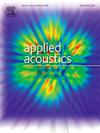A track-before-detect algorithm for underwater acoustic DSSS signal by introducing Doppler observation
IF 3.4
2区 物理与天体物理
Q1 ACOUSTICS
引用次数: 0
Abstract
Weak signal detection and tracking in the underwater acoustic (UWA) dual-spread channels are made difficult by the combined effects of the large ocean background noise fluctuations and extended, time-varying multipath. To account for these effects, we propose a track-before-detect (TBD) algorithm based on particle filter, incorporating Doppler observations within direct sequence spread spectrum (DSSS) systems to enhance signal tracking performance. In the proposed method, a multi-input TBD model with Doppler observation is developed, employing a joint likelihood function aligned with the measurement model to improve the distinction between weak signals and background noise, thereby improving weak signal detection probability. To further enhance the robustness of signal tracking, we introduce auxiliary variables to optimize particle sampling. The signal trajectory management strategies have also been developed to improve dynamic adaptability to variations in the number of multipath components. The performance of the proposed algorithm is confirmed through simulation analysis and shallow water horizontal channel experiments.
引入多普勒观测的水声DSSS信号检测前跟踪算法
在水声双扩频信道中,由于海洋背景噪声的大波动和扩展的时变多径的综合影响,使得微弱信号的检测和跟踪变得困难。为了解决这些影响,我们提出了一种基于粒子滤波的检测前跟踪(TBD)算法,在直接序列扩频(DSSS)系统中结合多普勒观测来增强信号跟踪性能。该方法建立了多输入多普勒观测的TBD模型,采用与测量模型一致的联合似然函数,提高了微弱信号与背景噪声的区分,从而提高了微弱信号的检测概率。为了进一步增强信号跟踪的鲁棒性,我们引入了辅助变量来优化粒子采样。此外,还开发了信号轨迹管理策略,以提高对多径分量数量变化的动态适应性。通过仿真分析和浅水水平通道实验验证了该算法的有效性。
本文章由计算机程序翻译,如有差异,请以英文原文为准。
求助全文
约1分钟内获得全文
求助全文
来源期刊

Applied Acoustics
物理-声学
CiteScore
7.40
自引率
11.80%
发文量
618
审稿时长
7.5 months
期刊介绍:
Since its launch in 1968, Applied Acoustics has been publishing high quality research papers providing state-of-the-art coverage of research findings for engineers and scientists involved in applications of acoustics in the widest sense.
Applied Acoustics looks not only at recent developments in the understanding of acoustics but also at ways of exploiting that understanding. The Journal aims to encourage the exchange of practical experience through publication and in so doing creates a fund of technological information that can be used for solving related problems. The presentation of information in graphical or tabular form is especially encouraged. If a report of a mathematical development is a necessary part of a paper it is important to ensure that it is there only as an integral part of a practical solution to a problem and is supported by data. Applied Acoustics encourages the exchange of practical experience in the following ways: • Complete Papers • Short Technical Notes • Review Articles; and thereby provides a wealth of technological information that can be used to solve related problems.
Manuscripts that address all fields of applications of acoustics ranging from medicine and NDT to the environment and buildings are welcome.
 求助内容:
求助内容: 应助结果提醒方式:
应助结果提醒方式:


